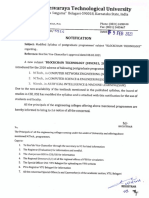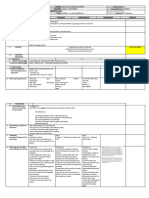Course Name:Blockchain Technologies ( Beginner Level )
Course Code:
Course Credit: 3-0-2
Course Objectives:
● Define blockchain and cryptography and identify their key components and principles.
● Evaluate the development, usage, and challenges of Bitcoin and other
cryptocurrencies.
● Assess the features and limitations of Ethereum and its role in supporting
decentralized applications and smart contracts.
● Synthesize the benefits and challenges of blockchain technology and identify potential
use cases in domains such as finance, healthcare, and supply chain management.
Course Content:
Theory
Unit 1: 9 Hours
Introduction of Cryptography and Blockchain
What is Blockchain, Blockchain Technology Mechanisms & Networks, Blockchain Origins,
Objective of Blockchain, Blockchain structure, Distributed networks- Distributed Applications
(DApps) – Web 3.0 - DApps Ecosystems, Blockchain Challenges, Transactions And Blocks, P2P
Systems, Keys As Identity, Digital Signatures, Hashing, and public key cryptosystems, private
vs. public Blockchain.
Unit 2: 9 Hours
Bitcoin
History- Bitcoin- usage, storage, selling, transactions, working- Invalid Transactions Parameters
that invalidate the transactions- Scripting language in Bitcoin- Applications of Bitcoin script-
Nodes and network of Bitcoin- Bitcoin ecosystem.
Unit 3 9 Hours
Crypto Currencies
Anonymity and Pseudonymity in Cryptocurrencies - Digital Signatures - Cryptocurrency Hash
Codes -Need for Crypto Currencies – Crypto Markets – Explore Crypto Currency Ecosystems -
�ICOs – Crypto Tokens - Atomic Swaps – Crypto Currency Exchanges – Centralised and
Decentralized Crypto exchanges – Regulations on Crypto Currencies & exchanges – Downside
of non-regulated currencies – crypto Scams – Exchange hacks.
Unit 4 9 Hours
Introduction to Ethereum
What is Ethereum, Introduction to Ethereum, Consensus Mechanisms, How Smart Contracts
Work, Metamask Setup, Ethereum Accounts, Receiving Ether’s What's a Transaction?,Smart
Contracts.
Unit 5 9 Hours
Blockchain Applications
Real-time IoT operating systems, Medical Record Management System, Domain Name Service,
Cross-border payments, Personal identity security, Supply chain and logistics monitoring, Anti-
money laundering tracking system and Future of Blockchain, Alt Coins.
Course Outcomes:
Upon Completion of the course, the students will be able to:
CO1: Understand and explore the working of Blockchain technology
CO2: Apply various blockchain concepts to analyze examples, proposals, case studies, and
preliminary blockchain system design discussions.
CO3: Discover the secure and efficient transactions with crypto-currencies
CO4: Experiment with cryptocurrency trading and crypto exchanges
CO5: Analyze the working of Smart Contracts
Text Books:
1. Narayanan, A., Bonneau, J., Felten, E., Miller, A., & Goldfeder, S. (2016). Bitcoin and
Cryptocurrency Technologies: A Comprehensive Introduction. Princeton University
Press.
2. Antonopoulos, A. M. (2018). Mastering Bitcoin: Programming the Open Blockchain.
O'Reilly Media, Inc.
3. Swan, M. (2015). Blockchain: Blueprint for a New Economy. O'Reilly Media, Inc.
4. Tapscott, D., & Tapscott, A. (2016). Blockchain revolution: how the technology behind
Bitcoin is changing money, business, and the world. Penguin.
Reference Books:
�● Nakamoto, S. (2008). Bitcoin: A Peer-to-Peer Electronic Cash System.
● Wood, G. (2014). Ethereum: A secure decentralised generalised transaction ledger.
Ethereum Project Yellow Paper, 151.
● Crosby, M., Pattanayak, P., Verma, S., & Kalyanaraman, V. (2016). Blockchain
technology: Beyond bitcoin. Applied Innovation, 2(6-10), 71-81.
● Swan, M. (2018). Token economies: The ultimate beginner's guide to token economics,
ICOs, and blockchain technology. CreateSpace Independent Publishing Platform.
List of Practical’s
1. Setting up a Private Blockchain Network:
● Install and configure a blockchain framework like Ethereum or Hyperledger
Fabric.
● Create a private blockchain network with multiple nodes running on different
machines.
2. Digital Signatures and Verifications:
● Implement a digital signature algorithm like RSA or Elliptic Curve Digital
Signature Algorithm (ECDSA).
● Generate a key pair consisting of a private key and a corresponding public key.
● Sign a message using the private key and verify the signature using the public
key.
● Experiment with different message and key pairs to understand the concept of
digital signatures.
3. Setting Up a Bitcoin Wallet:
● Choose a Bitcoin wallet software or application.
● Install the wallet on your device (desktop, mobile, or hardware wallet).
● Set up a new Bitcoin wallet by generating a private key and corresponding public
address.
� ● Familiarize yourself with the wallet's features, such as sending and receiving
Bitcoin, viewing transaction history, and managing security settings.
4. Exploring the Bitcoin Ecosystem:
● Research and explore various Bitcoin-related services and platforms, such as
Bitcoin exchanges, payment processors, and merchant services.
● Sign up for a Bitcoin exchange and go through the process of buying or selling
Bitcoin.
● Experiment with different Bitcoin wallets and compare their features, security
measures, and user experience.
5. Cryptocurrency Hash Codes:
● Implement a cryptocurrency hash function like SHA-256 or Keccak.
● Generate hash codes for different input data (e.g., messages, transactions, or
blocks) and compare the results.
● Explore the use of hash codes in verifying the integrity of cryptocurrency
transactions or blocks.
6. Setting Up an Ethereum Development Environment:
● Install and set up the necessary software tools like Node.js, Solidity compiler
(solc), and Ganache (a local Ethereum blockchain).
● Configure your development environment with an integrated development
environment (IDE) or text editor of your choice.
7. Crypto Tokens:
● Explore the creation and deployment of crypto tokens on blockchain platforms
like Ethereum.
● Develop a basic smart contract that represents a token and defines its
functionalities (e.g., transferability, supply, or utility).
● Deploy the smart contract on a test network and interact with the token.






















































































